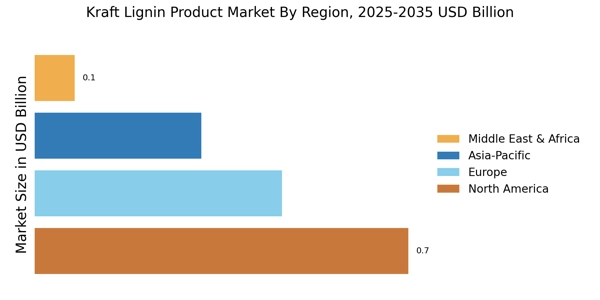Expansion of End-Use Industries
The Kraft Lignin Product Market is poised for growth due to the expansion of end-use industries such as construction, automotive, and packaging. These sectors are increasingly recognizing the benefits of incorporating lignin-based products into their supply chains. For example, in the construction industry, lignin can be utilized as a binding agent in composite materials, enhancing strength and durability while reducing environmental impact. The automotive sector is also exploring lignin as a lightweight alternative for various components, contributing to fuel efficiency. As these industries continue to expand and seek sustainable solutions, the demand for Kraft lignin products is expected to rise, creating new opportunities for manufacturers and suppliers within the market.
Growing Interest in Carbon Neutrality
The pursuit of carbon neutrality is becoming a central focus for many industries, significantly impacting the Kraft Lignin Product Market. As organizations commit to reducing greenhouse gas emissions, the demand for carbon-neutral materials is escalating. Kraft lignin, with its potential to sequester carbon during its production process, presents an attractive option for companies aiming to meet sustainability targets. Recent studies suggest that lignin can contribute to a reduction of up to 30% in carbon emissions when utilized in various applications. This growing interest in carbon neutrality not only drives demand for lignin products but also encourages research and development efforts within the Kraft Lignin Product Market, fostering innovation and new product offerings.
Increasing Adoption of Biobased Products
The Kraft Lignin Product Market is experiencing a notable shift towards biobased products, driven by heightened environmental awareness among consumers and industries. As companies strive to reduce their carbon footprints, the demand for sustainable alternatives to fossil fuels and synthetic materials is surging. Kraft lignin, derived from the pulping process, serves as a renewable resource that can replace petroleum-based products in various applications, including adhesives, coatings, and plastics. Recent data indicates that the biobased chemicals market is projected to reach USD 100 billion by 2025, suggesting a robust growth trajectory for lignin-based products. This trend not only aligns with The Kraft Lignin Product Industry.
Regulatory Support for Sustainable Materials
The Kraft Lignin Product Market benefits from increasing regulatory support aimed at promoting sustainable materials. Governments worldwide are implementing policies and incentives to encourage the use of renewable resources and reduce reliance on non-renewable materials. For instance, various countries have established mandates for the use of biobased products in government procurement processes. This regulatory environment fosters innovation and investment in the development of lignin-based solutions. As a result, companies operating within the Kraft Lignin Product Market are likely to experience enhanced market access and competitive advantages, as compliance with sustainability regulations becomes a critical factor in procurement decisions.
Technological Innovations in Lignin Processing
Technological advancements in lignin processing are significantly influencing the Kraft Lignin Product Market. Innovations in extraction and purification techniques are enhancing the quality and yield of lignin, making it more commercially viable for various applications. For instance, recent developments in enzymatic processes and membrane filtration are enabling more efficient lignin recovery from black liquor, a byproduct of the pulping process. This not only reduces waste but also increases the availability of high-purity lignin for use in specialty chemicals and materials. As these technologies continue to evolve, they are likely to drive down production costs and improve the competitiveness of lignin products, thereby stimulating growth within the Kraft Lignin Product Market.


















Leave a Comment